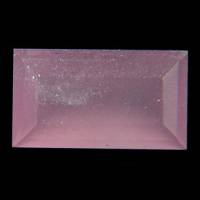Muscovite

Brazil
1.94 carats
© Mineral Classics
Muscovite is the most common member of the Mica Group. It typically occurs as massively crystalline material in "books" or in flaky grains.
Muscovite can be pink, colourless, silver-white, yellowish, greenish with a pearly luster on cleavage faces. It often has a sparkly look.
Because of its silvery sheen, Muscovite is sometimes called cat's silver.
Muscovite Gemstones by Colour
This table shows the variety of hues this gemstone can be found in. Click on a photo for more information.
| General Information | ||||||||||||||||||
|---|---|---|---|---|---|---|---|---|---|---|---|---|---|---|---|---|---|---|
| Varieties/Types: | Fuchsite - A greenish chromium-bearing variety of Muscovite. Verdite - A green ornamental stone, primarily an impure Fuchsite from South Africa. | |||||||||||||||||
| Chemical Formula |
| |||||||||||||||||
| Physical Properties of Muscovite | ||||||||||||||||||
| Mohs Hardness | 2 to 3, Gemstones of the world (2001) More from other references | |||||||||||||||||
| Specific Gravity | 2.78 to 2.88, Gemstones of the world (2001) More from other references | |||||||||||||||||
| Tenacity | Flexible,Elastic, Handbook of Mineralogy (2001) Laminae flexible and elastic; tough. | |||||||||||||||||
| Cleavage Quality | Perfect, Gemstones of the world (2001) More from other references | |||||||||||||||||
| Optical Properties of Muscovite | ||||||||||||||||||
| Refractive Index | 1.552 to 1.618, Handbook of Mineralogy (2001) | |||||||||||||||||
| Optical Character | Biaxial/-, Handbook of Mineralogy (2001) | |||||||||||||||||
| Pleochroism | Weak when colored., Handbook of Mineralogy (2001) | |||||||||||||||||
| Dispersion | Weak, Handbook of Mineralogy (2001) | |||||||||||||||||
| Colour | ||||||||||||||||||
| Colour (General) | Pink, colourless, silver-white, yellowish, greenish., Gemstones of the world (2001) More from other references | |||||||||||||||||
| Transparency | Transparent,Translucent, Gemstones of the world (2001) More from other references | |||||||||||||||||
| Lustre | Vitreous,Pearly, Gemstones of the world (2001) On cleavage surfaces mother-of-pearl lustre.More from other references | |||||||||||||||||
| Crystallography of Muscovite | ||||||||||||||||||
| Crystal System | Monoclinic, Gemstones of the world (2001) More from other references | |||||||||||||||||
| Habit | Crystals tabular to columnar, striated, pseudohexagonal or diamond-shaped. As stellate aggregates, plumose, globular; scaly, granular, compact massive., Handbook of Mineralogy (2001) | |||||||||||||||||
| Geological Environment | ||||||||||||||||||
| Where found: | A common rock-forming mineral, in phyllites, schists, and gneisses; in granites, granite pegmatites, and aplites. Formed from other minerals under hydrothermal conditions; may be detrital or authigenic., Handbook of Mineralogy (2001) | |||||||||||||||||
| Further Information | ||||||||||||||||||
| Mineral information: | Muscovite information at mindat.org | |||||||||||||||||
